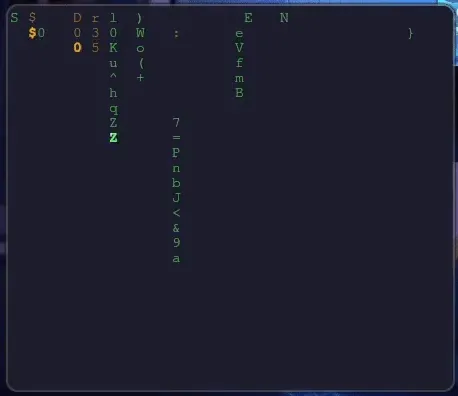


Writing a terminal based matrix digital rain is fairly simple; Even utilizing raw ANSI escape sequences, we can make one in under 20 lines of code with a shell scripting language like Bash. Similarly in most programming languages
For simplicity of the article, we won’t implement starting position, random initial character highlighting or anything too fancy. This implementation utilizes the Select Graphic Rendition, specifically the 4-bit green color sequence for portability as well
For a full-featured implementation, check out the matrix digital rain I wrote in Bash (the inspiration for this post!)
Bash is an excellent choice for this, because Bash comes pre-installed nearly everywhere. Most of the time it’s the default shell interpreter. When writing pure Bash, it’s super portable and easy to write. Generally Bash performs pretty well if usage of shell invoking procedures (such as command substituion) and external calls are limited
This is just a general, base concept for a minimal matrix digital rain
My mind works well off concepts - In hopes it could help you, I’ll leave this here to give some context on the implementation
Trap exit - cleanup
Initialize terminal
Loop forever
{
Calculate random column
Calculate random speed
Calculate random symbol length
Loop - over terminal lines
Calculate random symbol
Print down calculated column
If iteration > symbol length, erase
Sleep (print speed)
} Send to background
Sleep (print frequency)
You don’t have to use raw ANSI escape sequences, you can use an abstraction like tput or a TUI library I wrote for writing scripts exactly like this one, among others of course. But for performance and portability’s sake, it benefits to utilize ANSI escapes
Let’s start by initializing the terminal. How this works is up to you but I would utilize the terminal’s alternative buffer and disable the cursor. Using the alternative buffer has the advantage of disabling scrolling and allowing us to reset the terminal to its initial state
These sequences are VT100 ANSI escape sequences, which are the standard, that terminal manipulation libraries abstract away
init_term() {
# \e is an escape sequence
# the following sequences switch to the alternative buffer and hide the cursor
printf '\e[?1049h\e[?25l'
# sets terminal x and y to COLUMNS/LINES respectively
shopt -s checkwinsize; (:;:)
}
This is where it gets a little interesting! We have to do some basic equations. Here we utilize Bash’s builtin $RANDOM variable to give us a random integer in the specified range. First we should calculate our symbols starting column, then our symbols printing delay and finally the amount of symbols to print down a column. We should loop over the terminal lines plus symbol length and calculate a random symbol
Now it’s time to put all our random calculations to work! Simply print the random symbol to the calculated column down the iterated row (line) and follow up behind the symbol length with an erase sequence. Wrapping up our rain function, sleep with the calculated delay to give the rain varying speed. Almost there! This is the bulk of it, and the entire complexity of the implementation
rain() {
# random column between 1-terminal columns
((symbolCol=RANDOM%COLUMNS+1))
# random sleep delay between 1-9
((symbolSpeed=RANDOM%9+1))
# random length between 2-10
((symbolLen=RANDOM%9+2))
# walk the terminal lines + symbol length
for (( i = 0; i <= LINES+symbolLen; i++ )); do
# random symbol
symbol="${SYMBOLS:RANDOM%${#SYMBOLS}:1}"
# print green symbol down calculated column
printf '\e[%d;%dH\e[32m%s\e[m' "$i" "$symbolCol" "$symbol"
# erase after symbol length
(( i > symbolLen )) && printf '\e[%d;%dH\e[m ' "$((i-symbolLen))" "$symbolCol"
# rain (printing) speed
sleep "0.$symbolSpeed"
done
}
After defining our functions, the script is super simple, only requiring a run forever loop and call to our rain function, sent to the background, with a short sleep delay to prevent our rain from absolute downpour and potential CPU havoc. Modifying the terminal state is completely optional but worth it
Defining some symbols as a string
SYMBOLS='0123456789!@#$%^&*()-_=+[]{}|;:,.<>?'
Then we should probably trap some terminal cleanup so that we can reset our terminal state. Although one could just opt to close the terminal, skipping deinitializing and trapping interrupts entirely. Arguably the next step should be done first but in TUI scripts, it’s common to define signal handlers before calling functions
trap 'printf "\e[?1049l\e[?25h"' SIGEXIT
Next, we initialize the terminal by calling our init_term function
init_term
To finish it off, we execute the run forever loop, call our rain function in the background and sleep between calls for density
# loop forever
for((;;)) {
# call it and send it to the background
rain &
# rain density
sleep 0.1
}
That’s all!! Here is the entire implementation of our matrix digital rain in pure Bash using raw ANSI escape sequences, in under 20 lines of code!
init_term() {
printf '\e[?1049h\e[?25l'
shopt -s checkwinsize; (:;:)
}
rain() {
((symbolCol=RANDOM%COLUMNS+1))
((symbolSpeed=RANDOM%9+1))
((symbolLen=RANDOM%9+2))
for (( i = 0; i <= LINES+symbolLen; i++ )); do
symbol="${SYMBOLS:RANDOM%${#SYMBOLS}:1}"
printf '\e[%d;%dH\e[32m%s\e[m' "$i" "$symbolCol" "$symbol"
(( i > symbolLen )) && printf '\e[%d;%dH\e[m ' "$((i-symbolLen))" "$symbolCol"
sleep "0.$symbolSpeed"
done
}
trap 'printf "\e[?1049l\e[?25h"' exit
SYMBOLS='0123456789!@#$%^&*()-_=+[]{}|;:,.<>?'
init_term
for((;;)) { rain & sleep 0.1; }
I hope the post was thorough and able to teach you something! If not, well sorry, I tried! Anyway, you’re more than welcome to support the project by dropping a star on GitHub!
tags: matrix digital rain, terminal, TUI, bash